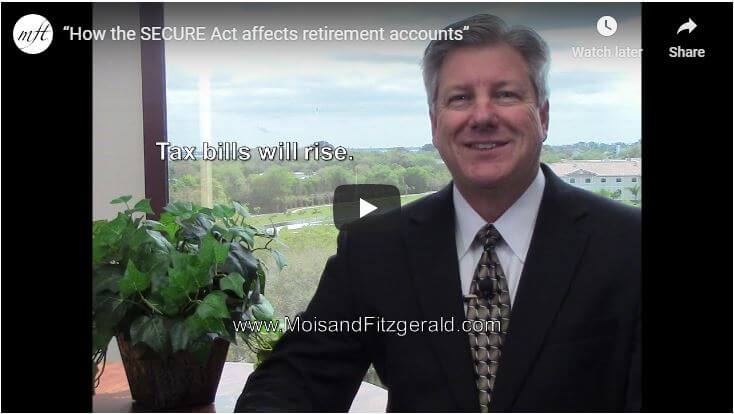How the SECURE Act affects retirement accounts
Several tax code changes were enacted when the SECURE Act (Setting Every Community Up for Retirement Enhancement Act) took effect on January 1, 2020.
We thought it would be more valuable to spare our clients the chore of perusing the 1,770 page document covering the entire bill and simply summarize the provisions most likely to affect our clients’ retirements. We will cover other elements of the legislation at another time.
Required Minimum Distributions (RMDs) will start at age 72, not 70½
Anyone subject to an RMD in 2019 (born on or before June 30, 1949) remains subject to an RMD under the prior rules. For everyone else, distributions will not be required from an individual’s IRA, 401(k), 403(b) or other retirement account until the year the owner turns 72. All other RMD rules, such as the scale that determines the amount of the RMD and the 50% penalty for failing to take an RMD, are unchanged.
…due to the CARES Act, no RMDs are required in 2020 for IRAs, Inherited IRAs, and the most common company-sponsored retirement plans
Note that due to the CARES Act, no RMDs are required in 2020 for IRAs, Inherited IRAs, and the most common company-sponsored retirement plans such as 401(k)s and 403(b)s, regardless of whether a taxpayer has been affected by COVID-19 or not. If you took any distributions in 2020 for RMD purposes, taxes on these distributions can be avoided by returning the funds to the IRA by August 31, 2020.
Contributions to a traditional IRA after age 70 ½ are now allowed
Prior to the SECURE act, workers over 70 ½ could contribute to a Roth IRA but not a traditional IRA. Beginning with the 2020 tax year, there is no longer an age limit for contributing to a traditional IRA. To contribute to any type of IRA, the IRA owner or spouse still must have “earned income,” which the tax code defines most commonly as income from work.
New requirements for Inherited IRAs, aka the end of the “stretch IRA”
Almost every client we serve will either inherit a retirement account (IRA, Roth IRA, 401(k), 403(b), 457 etc.) or will leave a retirement account upon their passing, so this change requires planning for almost everyone.
If the owner of a retirement account passed away in 2019 or earlier, there is no change to the Required Minimum Distribution rules.
If the owner of a retirement account passes away in 2020, only the following types of beneficiaries have the ability to take RMDs over their life expectancy under the pre-SECURE rules: spouses, persons less than ten years younger than the deceased (siblings typically), disabled persons, and minor children.
The SECURE Act effectively ended the “stretch IRA” for beneficiaries…
Under the pre-SECURE act rules, beneficiaries had the ability to take RMDs over their life expectancy. The SECURE Act effectively ended the “stretch IRA” for beneficiaries other than those exceptions listed above. Now, for persons passing in 2020 and later, distributions to individual beneficiaries must be made within 10 years. Beneficiaries can take out any amount they want whenever they want during the ten-year period, but the entire balance must be paid out within the ten years.
This usually means a full distribution must be made in a shorter time frame than previously required, likely resulting in less growth potential and more taxable income.
What can be done to manage the higher taxes created by the end of the stretch IRA?
Taxable income results when pre-tax money is distributed from a non-Roth retirement account. The tax payable on this income is based upon all the income and deductions on one’s return, filing status, and tax code at the time of the distributions.

Tax planning as an inheritor
Katie is single, 66 years old and intends to retire on December 31, 2021. Her Social Security, investment income, and $200,000 a year salary produces a taxable income of $207,350 after subtracting her deductions. This is the exact amount where the 35% tax bracket begins for a single filer. Katie’s uncle passes away in 2020 and leaves her a $150,000 IRA.
If Katie distributes the entire IRA account in 2020, her taxable income jumps to $357,350 and she will pay $99,868 in tax. That is $52,500 (35% of $150,000) in taxes on the IRA plus $47,368 on the $207,350 of taxable income she had before the IRA distribution.
The new law says the only requirement for Katie is that she distribute the entire account by the end of 2030. Katie should look for ways to take on more taxable income when low tax rates apply and less when high tax rates apply.
Katie could wait until she is retired and take the entire IRA distribution in 2022, the first year that she has no salary. Assuming the same tax profile, her taxable income drops to $157,350 because her salary ended. The tax brackets in 2022 will not be set until late 2021 but if we use the 2020 brackets, her tax bill would be more like $32,084 for a savings of over $67,000!
Katie could lower the total taxes even further by taking her first distribution in 2022 and planning to take distributions each year until the Required Minimum Distributions on her personal retirement accounts start in 2026. If she took $37,500 from the inherited IRA in each of those four years, her tax bill (using the 2020 scale) would be a mere $5,658 each year, roughly.
Tax planning as a benefactor
Frank is 80 years old and in poor health. His military retirement and Social Security benefits have always been enough to cover his expenses, so he has only taken the Required Minimum Distribution each year. He has $1,000,000 in his IRA. Frank does not want any more of his assets going to taxes than necessary.

Obviously, Sam will pay a high tax rate on any IRA money he inherits. Frank could reduce the tax bill by either distributing more than the RMD and leaving those funds to Sam or converting IRA money to a Roth IRA after he takes his RMD for the year. (RMDs cannot be converted.) By converting IRA funds to a Roth IRA, Frank is choosing to pay tax now at a lower rate rather than having Sam pay later at his much higher rate.
The Roth conversion strategy will work even better if Frank takes more than one tax year to convert, because the effective tax rate will be lower. The Roth IRA is also attractive because when Sam inherits the Roth IRA, Sam could let it grow tax free for up to ten years.
The church’s share should not be converted. It makes more sense to leave traditional IRA money and all its taxable income to the church because the church will be exempt from tax when it receives that income.
Tax planning pays
While the concept of getting taxable income taxed at the lowest rate available is simple, the implementation can get complex. Over time, income and deduction amounts change or one’s filing status could change. There can be multiple beneficiaries whose situations are very different and are also subject to change. Of course, the tax code itself is ever evolving.
There are many good reasons to use a trust, but the SECURE Act makes some trusts terrible beneficiaries from a tax standpoint.
Of particular concern with the new SECURE Act is the use of trusts as beneficiaries of retirement accounts. There are many good reasons to use a trust, but the SECURE Act makes some trusts terrible beneficiaries from a tax standpoint. We will wade into this complex subject at another time. For now, it is important that all beneficiary designations be chosen carefully and that any trusts named as beneficiaries be reviewed for needed revisions.
Rest assured, our team is here to help you understand how changes like those in the SECURE Act may affect you. We can work with your estate planning attorney on any needed revisions and develop an appropriate tax and investment strategy to help achieve your goals given your unique circumstances.
News & Notes

| Bank accounts lose money safely: When the stock market drops, it is natural to want safety but “safe” is a relative term. The record of world stock markets against inflation over substantive periods of time is excellent. The record of “safe” holdings is not good at all. A January 2020 study by Magnify Money of 1-yr CD and savings account rates underscores the notion that stable should not be mistaken for safe when it comes to inflation risk. Out of over 7,200 savings accounts, a paltry 10 offered a yield greater than the 2.3% increase in the Core Consumer Price Index and only 29 out of 5,400 1-year CDs yielded more than that amount. This study was conducted before the recent drop in interest rates and ignores taxes. Bank accounts like these are good places to hold reserve cash that may be needed in the short term, because of their stability. However over longer periods, because of inflation and taxes, they are almost destined to cause one’s purchasing power to erode. |
Source: Bureau of Economic Analysis; Bureau of Labor Statistics; Federal Reserve
No increase in Social Security benefits expected in 2021: In most years Social Security benefits increase due to inflation. Due to the economic slowdown and the drop in prices for many goods and services, many Social Security experts are predicting no cost of living adjustment (COLA) will be applied for 2021. This would mark the first time since 2016 and the fourth time since 2010 that no COLA was applied.
Please remember to call us: When anything significant happens in your life, including changes in your finances, family, or health that could affect your financial plan, please let us know so that we can adapt our planning and portfolio work for you accordingly. Also, if you ever fail to receive a monthly statement for one of the Schwab Institutional or TD Ameritrade Institutional accounts under our management, please let us know so we may assure the respective custodian delivers your statements promptly.
Yours truly,
The Team at Moisand Fitzgerald Tamayo, LLC

